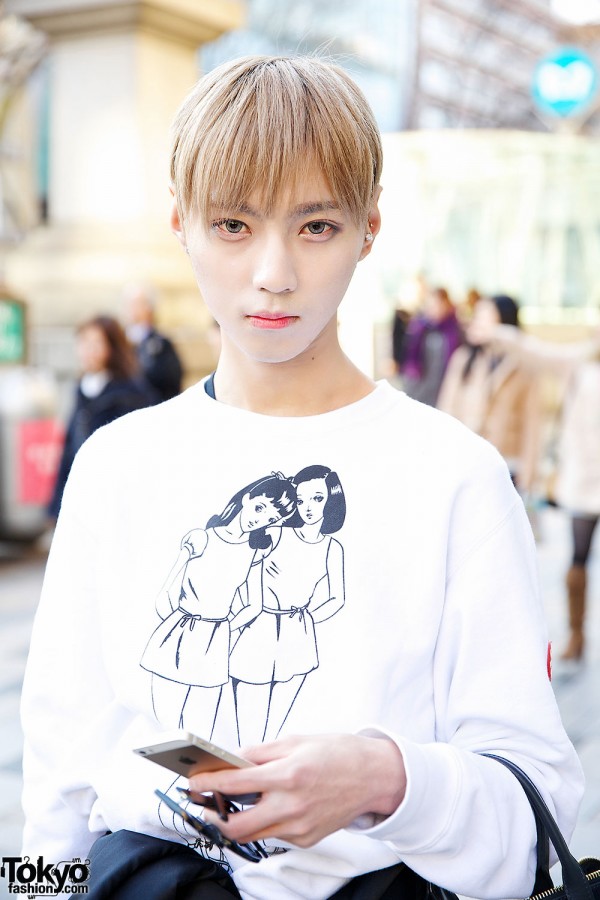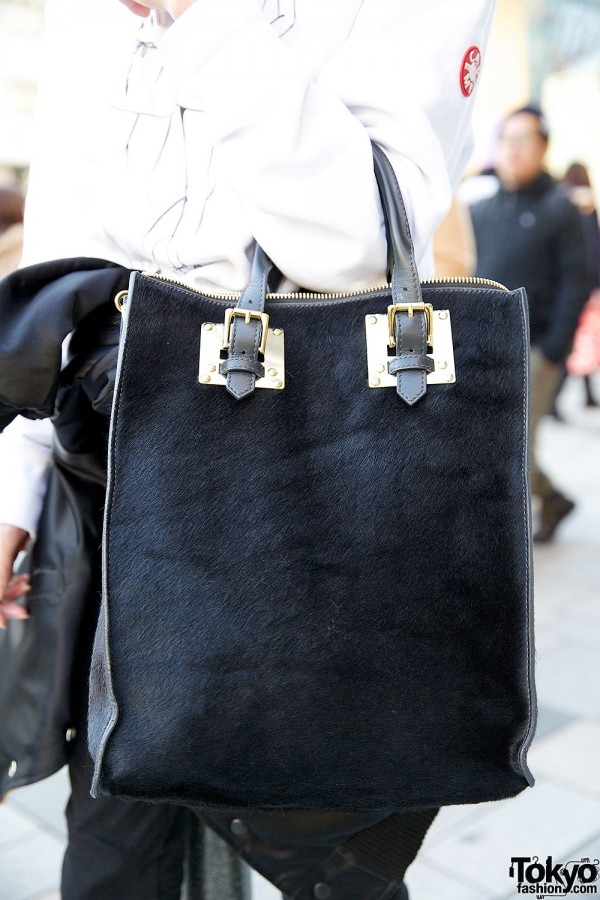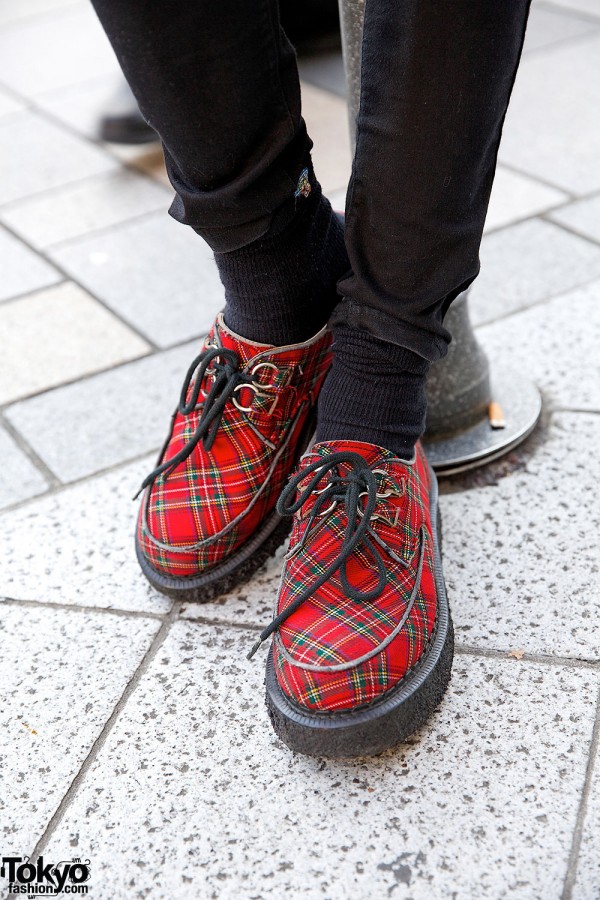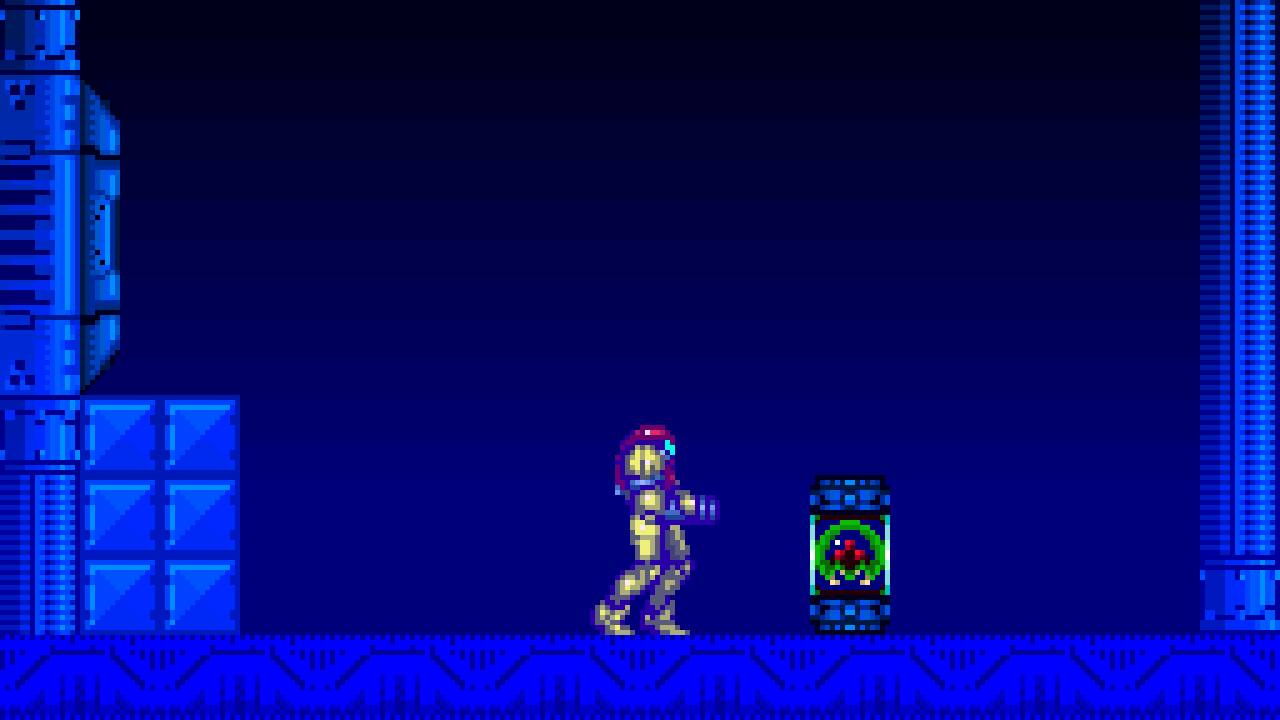Taylor Swift
Shared posts
5 LOW BUDGET VIDEOS FROM ITALY
The Virgin Mary Coat & lilLilly vs Kinji Jacket & Scissor Earrings in Harajuku
Arai and Urara are two 22-year-olds we recently snapped in Harajuku.
Arai is a hair salon assistant beautician. He’s wearing a Santa Monica black sweater with H&M pants and a resale Kinji jacket. His tote bag is Monikoto and his red patent loafers are LITTLEBIG x ORPHIC. His scissors shaped earrings are from Santa Monica, and we also noticed he is wearing a white circle scarf and sunglasses. Arai is a fan of Japanese rock band The Pillows. Find him on Twitter for more info.
Urara is a company employee and she’s wearing a light colored outfit that matches her hair. Her coat is from the famous Tokyo resale shop The Virgin Mary, worn over a LilLilly dress and Peu Pres cardigan. Her tote bag is from Mana. We also noticed her round glasses, beret, hair bow, star necklace and white oxfords. Urara told us that she likes shopping at The Virgin Mary, and that she’s a fan of Bump of Chicken, Back Number and Howl Be Quiet. Find out more about her on Twitter.










Click on any photo to enlarge it.
Rolling Stone interviews Flappy Bird creator in Hanoi
Taylor SwiftSORRY IM GOING THROUGH MY OLD WAXY.ORG LINKS. This piece is a really great tonic to the flood of insufferable faux-journalism about Nguyen—for one, THEY ACTUALLY WENT TO VIETNAM AND LEARNED ABOUT VIETNAMESE GAME DEVELOPMENT CULTURE INSTEAD OF ASSUMING AND BLOVIATING.
Alice and the Pirates, Black Peace Now & Baby the Stars Shine Bright in Harajuku
Taylor SwiftYES
We met Haruna – a friendly girl who works in a vintage shop – on the street in Harajuku.
Haruna is wearing a top and skirt from Alice and the Pirates, with a ruffle capelet from Black Peace Now and a faux fur cowl. Her tote bag is Q-Pot and her bow flats with cross straps are from Baby the Stars Shine Bright. She told us her accessories are from Alice and the Pirates, including a red beret, bow pins and bow hair ties.
Haruna’s favorite fashion brands are Alice and the Pirates and Baby The Stars Shine Bright.








Click on any photo to enlarge it.
[Video] Super Mario Bros Developers Story: Who Made What!
Taylor SwiftNINTENDO EAD4, YOU ARE MY NEW ENEMY
Marco Arment on the value of understanding web hosting for app developers
Twin Sisters Naru and Nari in Harajuku w/ Resale Denim & Cute Hairstyles
Nari and Naru are 19-year-old twin sisters who we often see around Harajuku. This time, they were both wearing denim!
Nari is pictured to the left, in a resale gingham shirt dress with a resale Ralph Lauren denim shirt on top. Her tote bag is from the band Plenty, and her sneakers are Puma. She accessorized with a G-shock watch. Nari told us she loves shopping at resale shops in Shimokitazawa. She’s also a big music fan, especially pop and rock. Nari is active on Twitter.
Naru is a student and she’s pictured to the right, in a NY cap. She’s wearing denim overalls with a white turtleneck and tartan scarf. Her backpack is from Gregory and her shoes are Dr. Martens. She told us she also likes resale shops in Shimokitazawa, as well as Vivienne Westwood and I am I. Her favorite band is Champagne and she’s also on Twitter.









Click on any photo to enlarge it.
The 10 Greatest Metroidvania Games
Taylor SwiftNO TOMBA, NO CREDIBILITY
moe, moe, moe / why don’t you like me, nobody likes me

moe, moe, moe / why don’t you like me, nobody likes me
Lovely Weather For Ducks
Taylor SwiftThis is a perfect comic because when it's not being metaphysical it is instead just very gentle

“Love has knocked us down and scored”
Taylor SwiftYes yes yes yes yes yes yes yes yes yes yes yes yes yes yes yes yes yes yes yes yes yes yes yes yes yes yes yes yes yes yes yes yes yes yes yes yes yes yes yes yes yes yes yes yes yes yes yes yes yes yes yes yes yes yes yes yes yes yes yes yes yes yes yes yes yes yes yes yes yes yes yes yes yes yes yes yes yes yes yes yes yes yes yes yes yes yes yes yes yes yes yes yes yes yes yes yes yes yes yes yes yes yes yes yes yes yes yes yes yes yes yes yes yes yes yes yes yes yes yes yes yes yes yes yes yes yes yes yes yes yes yes yes yes yes yes yes yes yes
Rinko Kawauchi


Photograph of Mount Aso from “Ametsuchi” by Rinko Kawauchi, available at Spaces Corners, via Shift:
“I felt that I was standing on the planet for the first time.”
Cowbell Splatter Pattern
Taylor SwiftYESSSSSSS
Gimp My Ride : W*A*S*P Guitarist Has A Used Car For Sale, Does Not Advise Driving Like A Beast
Taylor SwiftNooooo
Unless and until Blackie Lawless’ Segway hits the auction block, Chris Holmes’ 1987 Firebird might the ultimate item to complete your W*A*S*P-related methods-of-transportation memorabilia collection. Snap it up now, before some wealthy W*A*S*P fan drops it in the parking lot of the Experience Music Project.
"They want to lock everyone into everything, just like everyone else."
Maybe the reason Prime economics have become tricky is because Amazon bundled in a video service nobody wants since 2011, leveraging one business' extreme success to juice the numbers of one that's faring poorly against its competitors. Netflix charges $95.88 per year for a similar service. How much of Prime's price hike was really to help pay for the video service that's just a tax on Prime members who have never used it and don't want it?This isn't just an Amazon problem. In the last few years, Google, Apple, Amazon, Facebook, and Twitter have all made huge attempts to move into major parts of each others' businesses, usually at the detriment of their customers or users.
Google, the geek world's undeserved, unquestioned darling for well over a decade, has made all of its core products worse by forcefully shoving Google+ into them. They're leveraging extreme success from some businesses (search, email, maps) to juice the numbers of one that's faring poorly against its competitors (Google+). Sound familiar?
Apple's Maps is still worse and has fewer features than Google Maps, which was previously integrated better into the iPhone and didn't enable as much Google tracking creepiness. Not anymore. (Although I think the fault of this is shared between Apple and Google.) Many of Apple's other applications and services have suffered as well as they've spread themselves too thinly and competed on more fronts.
The battle between Twitter and Facebook has made both products worse and caused weird restrictions to users on both sides, such as the walls both companies have installed between Twitter and Instagram. Twitter is now ultra-paranoid, defensive, aggressive, and full of annoying ads. Facebook's core product is a mess as it continually tries (and fails) to capture the usage and style of Twitter, while annoying people more and more to keep its ads effective. (At least Facebook is consistent: they've always been getting worse.)
Amazon making its retail business worse to prop up another part of its ecosystem shouldn't be a surprise to anyone. Amazon doesn't want you to be only a retail customer anymore, and they'll keep making it harder to be.
They want to lock everyone into everything. Just like everyone else. And we're all worse off for it.
The Secret Lives of Inner-City Black Males
On Sunday, I took my son to see two movies at a French film festival that was in town. The local train was out. We walked over to Amsterdam to flag down a cab. The cab rolled right past us and picked up two young-ish white women. It's sort of amazing how often that happens. It's sort of amazing how often you think you are going to be permitted to act as Americans do and instead receive the reminder—"Oh that's right, we are just some niggers. I almost forgot."
Getting angry at the individual cabbie is like getting angry at the wind or raging against the rain. In America, the notion that black people are lacking in virtue is ambient. We see this in our vocabulary of politics and racism, which has no room for the decline in the out-of-wedlock birthrate and invokes Chicago with no regard for Chicago at all, but to deflect all eyes from the body of Trayvon Martin.
But I was angry, and very much wanted to approach the cabbie, idling there at a red light, in ill disposition. I was also with my son. And more, I am a 6-foot-4 black dude who tries to avoid the police. I think, 15 years ago, with nothing to lose, I would have made a different decision, if only because the culture of my young years made a virtue of meeting disrespect with aggression. This culture was not wrong—the price of ignoring disrespect, in the old town, was more disrespect. The culture was a collection of the best practices for making our socially engineered inner cities habitable. I now live in a different environment. I now have different practices.
Last week, Paul Ryan went on the radio to address the lack of virtue prevalent among men who grew up like me, my father, my brothers, my best friends, and a large number of my people:
We have got this tailspin of culture, in our inner cities in particular, of men not working and just generations of men not even thinking about working or learning the value and the culture of work, and so there is a real culture problem here that has to be dealt with.
A number of liberals reacted harshly to Ryan. I'm not sure why. What Ryan said here is not very far from what Bill Cosby, Michael Nutter, Bill Clinton, and Barack Obama said before him. The idea that poor people living in the inner city, and particularly black men, are "not holding up their end of the deal" as Cosby put it, is not terribly original or even, these days, right-wing. From the president on down there is an accepted belief in America—black and white—that African-American people, and African-American men, in particular, are lacking in the virtues in family, hard work, and citizenship:
If Cousin Pookie would vote, if Uncle Jethro would get off the couch and stop watching SportsCenter and go register some folks and go to the polls, we might have a different kind of politics.
Cousin Pookie and Uncle Jethro voted at higher rates than any other ethnic group in the country. They voted for Barack Obama. Our politics have not changed. Neither has Barack Obama's rhetoric. Facts can only get in the way of a good story. It was sort of stunning to see the president give a speech on the fate of young black boys and not mention the word racism once. It was sort of stunning to see the president salute the father of Trayvon Martin and the father of Jordan Davis and then claim, "Nothing keeps a young man out of trouble like a father who takes an active role in his son’s life."
From what I can tell, the major substantive difference between Ryan and Obama is that Obama's actual policy agenda regarding black America is serious, and Ryan's isn't. But Ryan's point—that the a pathological culture has taken root among an alarming portion of black people—is basically accepted by many progressives today. And it's been accepted for a long time.
Peddlers of black pathology tend to date the decline of African-American virtue to the 1960s. But pathology arguments are much older. Between 1900 and 1930, blacks were three times as likely as whites to be killed. Their killers tended to be black—black were 80 percent of Mississippi's murderers and 60 percent of its victims. According to historian David Oshinsky, the actual murder rate among African-Americans was likely higher. "We had the usual number of [Negro] killings during the week just closed," the Jackson Clarion-Ledger reported in 1904. "Aside from the dozen or so reported in the press, several homicides occurred which the county correspondents did not deem sufficient for the dispatches."
Oshinsky reports that "many of the murders involved liquor, gambling and personal disputes." Did the ghastly amount of violence afflicting black Mississippians spring from poor blacks "not holding up their end of the bargain?" Or was it the the fact that black Mississippians were living in a kleptocracy that had no regard for their lives? As Khalil Muhammad shows in his book The Condemnation of Blackness, progressives and conservatives alike often argued for the former.
Certainly there are cultural differences as you scale the income ladder. Living in abundance, not fearing for your children's safety, and having decent food around will have its effect. But is the culture of West Baltimore actually less virtuous than the culture of Wall Street? I've seen no such evidence. Yet that is the implicit message accepted by Paul Ryan, and the message is bipartisan.
That is because it is a message that makes all our uncomfortable truths tolerable. Only if black people are somehow undeserving can a just society tolerate a yawning wealth gap, a two-tiered job market, and persistent housing discrimination.
I think of that cab driver passing me by on Amsterdam. We are not on the block anymore. We are in America, where our absence of virtue is presumed, and we must eat disrespect in sight of our sons. And who can be mad in America? Racism is just the wind, here. Racism is but the rain.
Owen Pallett – On a Path
Taylor SwiftMox Jet at 2:45
It begin with strings: the melody as hard as silver, its sweep as fluid as water. The lyrics aim for an aphoristic power shunned by most songwriters, but most songs aren’t as thought-through as Pallet’s, and most acts hire string arrangements to add histrionics to songs which deserve less. I don’t know if Pallett wrote the words to the accompaniment of the strings he heard in his head; the precision, lack of color, and uncluttered metaphors suggest pencils tracing on paper. He stands in a city he doesn’t know anymore because self-knowledge brings no happiness. Like his strings, his voice limns its emotional range and not a note more. This is neither restraint nor trepidation – it’s confidence.
Game 140: Tunnels of Doom (1982)
Taylor SwiftFeel free to stop reading this after the title screen, but OHHHHH WHAT A TITLE SCREEN.
Kevin Kenney (author)
Date Ended: 9 March 2014
Final Rating: (to come later)
Ranking at Time of Posting: (to come later)
Tunnels of Doom is the subject of many fond remembrances by people who were 10 in 1982 and had a TI-99. I can see why. It offers innovative elements, good use of sound, and fun encounters, and its party-based combat screen might be the most tactical combat system we'd seen (in 1982) outside of Wizardry. It certainly deserved a look.
I don't know that I'd recommend it for a 2014 player. It involves learning an emulator that isn't necessary for many other games (the only other RPGs I can find for a TI-99 are Legends and Legends II), mastering a keyboard layout that makes no sense except on a native keyboard, and getting an RPG experience that isn't exactly going to draw your attention away from Dark Souls. Fortunately, that's what I'm here for.
| The TI-99/4A keyboard. There were no separate arrow keys, so the game uses the ESDX cluster for movement and the FCTN combinations for "proceed" and "back." |
Tunnels of Doom was one of dozens of programs (but the only RPG) written internally at Texas Instruments as a way to promote the computer. Technically, Tunnels of Doom is the name for the overall game engine, and the idea was there would be multiple scenarios playable under that engine. The game shipped with two of them: Pennies and Prizes and Quest of the King. The former was a children's game that featured collecting treasure but no enemies. The latter is what people remember as the core game. In it, you lead a party of up to four characters in a quest to find both a kidnapped king and his magic Orb of Power. You have a limited number of turns to accomplish these tasks.
The player has a lot of control over the game's difficulty. You get to determine how many floors the game has (from up to 10), the overall game difficultly (easy, medium, hard), and how many characters to include in the party. A multi-character party can include fighters, thieves, and wizards, or you can adventure with a solo "hero" who has the abilities of all classes. Fighters can use any weapons and armor, thieves have a trap-avoidance ability, and wizards can use scrolls. You have to repeatedly reference your characters' names in-game when assigning items and taking actions, so it's best not to name them things like "Mxyzptlk."
| Character creation. |
The top level of the dungeon has a general store where you initially equip your characters from a pool of gold. Theoretically, you can return to it later to buy better equipment, but it's usually best not to waste the time.
| Buying stuff at the beginning of the game. |
Once you set the parameters, the dungeon levels are randomly-generated and seeded. They consist of a bunch of twisty corridors, which you explore in first-person view . . .
. . . ending in rooms that you explore in third-person view. In this, they are similar to what we'll later see in Ultima IV and V. The game gets a lot of praise for using color in an era in which the typical dungeon crawler used wireframe graphics, but to me the color doesn't really add to any substance. I rather prefer the bare-bones wireframes, and the bleak sense they convey, to traveling through pastel-colored dungeons.
| This room contained one of the objects of my quest. |
Rooms might contain any of the following:
- Enemies to fight
- Miscellaneous treasures
- Treasure chests, which might contain armor, weapons, gold, scrolls, or maps of the level
- Vaults to open
- Secret doors leading to unmapped parts of the level
- Fountains, which randomly increase or decrease attributes
- "Living statues," which take money to identify unidentified magic items
| Donating money to a living statue to identify that "unknown scroll." |
In combat, this is one of the few games of the era in which you didn't just hit (F)ight and hope for the best. Each character gets a movement action and an attack action each round. There are some tactics associated with maneuvering party members into melee range or staying in missile range, swapping magic items between characters, and conserving magic scrolls for when you really need them. It isn't anything earth-shattering, but it does anticipate the more complex iconographic combat systems we'd see in SSI games, including Wizard's Crown, Shard of Spring, and ultimately the Gold Box series.
| Fighting two "evil manes." |
Characters level quite slowly as they accumulate experience, gaining 5 hit points for every new level, but rarely exceeding in character levels the number of levels in the dungeon. Characters don't "die" in the game. If their wounds exceed their hit points, they'll become "disabled." At that point, they can be healed by fountains or by purchasing healing at the general store, or slowly by eating rations. The dynamic makes it more likely that you'll lose the game because the quest times out than because of full-party death.
| The "character status" window. |
The number of turns you have available to complete the quest is dependent on the number of dungeon levels and the difficulty. Each turn comprises 10 steps (including checking secret doors and listening at doors), so you don't want to waste time.
| The game is one of the first to feature an automap. I found a level map in one of the rooms, so the part that I've yet to explore is in blue. |
There are two gameplay elements in Tunnels of Doom that I've seen in no other games in my chronology. The first is the ability to "listen at doors" before you enter rooms. If there's a monster in the room, the action will produce the sound normally made by that monster in combat. Since it's hard to record notes about a sound, my scratchpad is filled with entries like:
- "Boop-dit-dit-dit-dit" = Lizard
- High-pitched "do-do-do" = Rat
| A successful lockpicking. I got lucky with a couple of my guesses. |
| My quest status. I have 200 movements left to find the king. |
| The victory screen takes place back at the dungeon entrance. Notice the down stairs and the little store. |
Chroma Squad takes us under the helmet
Taylor SwiftOMFG
When Clancy named Chroma Squad as one of Pocket Tactics‘ most anticipated games of 2014, he did so on the strength of the game’s memorably weird set-up (run your own Power Rangers-esque TV production company) and the promise of developer Behold Studios’ first game, Knights of Pen & Paper – because we hadn’t actually seen much gameplay footage of the game since it was revealed last summer.
Behold released this new video over the weekend which packs a lot of gameplay into a comedy Japanese infomercial for the game. I love the X-Com-esque blend of gameplay styles: on the strategic level you have to profitably run your TV production company, and on the tactical end you fight the turn-based battles between your actors and stuntmen to record for the show.
Still no solid release date for this one but it can’t be too far away — the game is going into beta soon. It’s bound for PC, Android, and iOS. Watch the trailer after the jump.
"A hate flower that blooms all year". Also, Space Egyptians.
Taylor SwiftI shared this around the office last week, and MAYBE not all of these quibbles are TOTALLY legit, but it was one hell of a cathartic read.
A modern Web page is a catastrophe. It's like a scene from one of those apocalyptic medieval paintings that depicts what would happen if Galactus arrived: people are tumbling into fiery crevasses and lamenting various lamentable things and hanging from playground equipment that would not pass OSHA safety checks. This kind of stuff is exactly what you'll see if you look at the HTML, CSS, and JavaScript in a modern Web page. Of course, no human can truly "look" at this content, because a Web page is now like V'Ger from the first "Star Trek" movie, a piece of technology that we once understood but can no longer fathom, a thrashing leviathan of code and markup written by people so untrustworthy that they're not even third parties, they're fifth parties who weren't even INVITED to the party, but who showed up anyways because the hippies got it right and free love or whatever. [...]Describing why the Web is horrible is like describing why it's horrible to drown in an ocean composed of pufferfish that are pregnant with tiny Freddy Kruegers -- each detail is horrendous in isolation, but the aggregate sum is delightfully arranged into a hate flower that blooms all year. [...]
So, yes, it would be great if fixing your browser involved actions that were not semantically equivalent to voodoo. But, on the bright side, things could always be worse. For example, it would definitely be horrible if your browser's scripting language combined the prototype-based inheritance of Self, a quasi-functional aspect borrowed from LISP, a structured syntax adapted from C, and an aggressively asynchronous I/O model that requires elaborate callback chains that span multiple generations of hard-working Americans. OH NO I'VE JUST DESCRIBED JAVASCRIPT. What an unpleasant turn of events! People were begging for a combination of Self, LISP, and C in the same way that the denizens of Middle Earth were begging Saruman to breed Orcs and men to make Uruk-hai.
Previously, previously, previously, previously, previously, previously, previously.
Yusuke Devil in Harajuku w/ C.E, Sophie Hulme & Tartan Creepers
Taylor SwiftTaking notes here tbqh
Yusuke Devil is a style icon around the streets of Harajuku. You may recognize him from our previous street snaps – or from his popular Twitter and Instagram feeds. Devil is 18 years old and works at his favorite boutique, Faline Tokyo.
This time, Devil is wearing an illustrated sweatshirt from C.E with skinny jeans and a Richardson jacket tied around the waist. His furry bag is from Sophie Hulme and tartan creepers are Dr. Martens. Devil is also wearing Ksubi sunglasses and several piercings.





Click on any photo to enlarge it.
Yuri Nakagawa w/ lilLilly, Chocomoo & Fleamadonna in Harajuku
Yuri Nakagawa is a Japanese fashion blogger and magazine model whom we often see around Harajuku. This time, her look included short blonde hair and a faux fur cap.
Yuri’s knitted top and skirt are from lilLilly and they feature textured loops. Her jacket is Fleamadonna, her backpack is Topshop and her silver platform ankle boots are also lilLilly. She is also wearing Chocomoo earrings and a neon faux fur scarf from Moussy. We also noticed her nail art and Chocomoo x Avantgarde Harajuku tights.
Yuri told us she likes to shop at Candy and Bubbles, and that she listens to electro music, dubstep and k-pop. Find out more about her by following her Twitter and Instagram.







Click on any photo to enlarge it.
Why Do Japanese Games Have, Like, Double-Text?
Taylor SwiftThis rules
A reader named Joe asked a question about Japanese text that actually tends to pop up on a regular basis:
Hello. I recently came across a screenshot of animal crossing, and I was confused about something. If you look in the attached picture, it shows regular Japanese text, but for some of the bunches of text, there is text above it in a smaller font. What is up with that?
And here’s the picture Joe attached:
 |
As you can see, there seems to be small text above the regular text there… What the heck is this craziness?!
The quick answer is that the extra text above normal text is basically a pronunciation guide.
There IS a little more to it than that, though.
Japanese Writing Systems
In super-simple terms, Japanese writing comes in two forms: kanji and kana.
Kanji originates from Chinese and generally looks a bit complicated, you know, stuff like 影響 and 爆弾 and 馬鹿. There are thousands of kanji characters and each one usually has multiple meanings and pronunciations that you gotta memorize.
Kana is a bit more like a “syllable alphabet” and generally looks simpler, with stuff like この and ハロー and そら. Because it’s based around syllables, kana is usually super-easy to read and pronounce. There aren’t many kana, so you can easily master it in a few days.
Anyway, standard Japanese writing uses a mix of both kanji and kana, as well as a dash of English. The problem is that because Japanese kanji can be read in so many ways, sometimes it’s not always clear which reading is intended. For example, just the basic kanji character 下 has like a dozen possible readings!
 |
So, when a Japanese writer wants to make sure readers know how to pronounce a bunch of kanji, it’s common practice to put the pronunciation in kana above it. This type of kana that appears above kanji is known as furigana.
If we had furigana in English, I suppose it might look something like this:
 |
Anyway, since it takes many years to master all the standard Japanese kanji, it’s normal to see furigana in stuff aimed at kids. That’s why it’s so common in games and manga and such.
But it’s not by any means a kids-only thing. Japanese names are usually written in kanji, and including the pronunciation on your business cards or form applications or whatever else is extremely common. In fact, Japanese names are so crazy that there are huge dictionaries and resources just for name pronunciations!
 |
Basically, have you ever had someone read your name out loud but pronounce it wrong? That problem is much worse in Japanese, so furigana serves as a solution.
Furigana is also super-helpful when it comes to learning the language and when learning kanji. So furigana acts as a crutch sometimes, and as a helpful resource other times. It’s a really neat aspect of the Japanese language!
 |
Furigana Everywhere
Furigana is seriously everywhere in Japanese! It’s in games, of course:
 |
 |
…Although due to memory and hardware limitations it’s not very common in older games.
Furigana is also very common in manga and such:
 |
 |
Furigana is common in books of various types, too:
 |
 |
Furigana is sometimes used on TV:
 |
Furigana is very important when it comes to Japanese karaoke:
 |
Most mainstream newspapers DON’T use furigana in the main articles, but it’s still common to see furigana in other parts:
 |
It’s common to see furigana on really important signs too, like train station signs. Many train stations in Japan also helpfully include the names written out in English for folks like us!
 |
So if you ever see small text on top of normal-sized Japanese text, now you know what it is!
Advanced Furigana
By some crazy coincidence, I received another e-mail on the same day by another reader named EmpoleMew that was also about furigana:
To make a long story short, with the extremely minuscule knowledge I have of Japanese, I know that furigana is meant to provide a sort of pronunciation guide to kanji (and foreign characters) that may be unfamiliar or hard to read because of small print. However, as an avid player of Yu-Gi-Oh, I’ve noticed that some Japanese card names have furigana that actually gives the card a name completely different from the kanji. The example that led me to asking the question is a new card, whose name is spoken in the anime and written in furigana on the actual card as “Rank-Up-Magic The Seventh One”, but whose kanji says the name of the card is “Rank-Up-Magic Swords of the Seven Emperors”! Knowing the context of the anime, the Seven Emperors name makes sense, referring to the characters using the card, but this name is never spoken by anyone, and the double name will be lost to localization like many other things in the game.
So the question (or questions I guess) here is, is this a common practice in Japanese media, and can you think of any possible reasons for doing it? Have you ever come across situations like this in any of your translation work, professional or personal? I eventually plan to get into localization work myself in the future, and I feel like this is something I need to be weary of.
So we’ve seen how furigana can tell readers now how to pronounce kanji. But on occasions a writer can use furigana to create a totally custom pronunciation or give extra information – which is actually extremely common in Japanese entertainment!
Just because I happen to have it handy, here’s an example from the Fairy Tail manga:
 |
Here, he’s saying 妖精の尻尾, which would normally have the furigana of ようせい (yousei, fairy) and しっぽ (shippo, tail). But the author decided to give it a CUSTOM pronunciation instead: フェアリーテイル (fearii teiru, Fairy Tail). From this, Japanese readers can tell how to pronounce the word AND what the word actually means.
Here’s another example:
 |
Here, the highlighted words 滅竜魔導士 and 魔水晶 both have this custom furigana. 滅竜魔導士 (metsuryuu madoushi) is meant to be read out loud as “Dragon Slayer” and 魔水晶 (masuishou) is meant to be read out loud as “lacrima”.
The writer could’ve easily just used “Dragon Slayer” and “lacrima” directly in the text. But with the custom furigana, readers can pronounce it the intended way AND know what these names actually mean. It’s a pretty nifty trick!
So, as a translator, how are you supposed to handle all this double-meaning, double-information stuff? The answer is that it’s pretty much a case-by-case basis, and no matter what you do something will get lost in the translation. I come across it a lot in my own work, so maybe I’ll try to document some cases for a future post. Usually it comes down to personal preference, or, if you’re super-duper lucky, you can ask the company or creator about it.
Anyway, whew! So that’s the quick look at the wacky world of Japanese double-text and the cool stuff it can be used for! Even if you don’t plan on learning Japanese, hopefully this gives you a little more insight on how other languages try to handle the “How the heck do you pronounce this word?!” problem.
To be honest, there’s actually a LOT more to furigana than what we’ve seen here; it can often be used for jokes, word play, creating catchy phone numbers, memorable marketing slogans, and more. So who knows, maybe they’ll come up in future articles! But for now let’s let our brains rest a little ![]()














 Ace Attorney Kanji and Japanese Typos
Ace Attorney Kanji and Japanese Typos What Does That Weird Text in Ninja Games Mean?
What Does That Weird Text in Ninja Games Mean? Q&A: Super Metroid and English Games with Japanese Text Options
Q&A: Super Metroid and English Games with Japanese Text Options